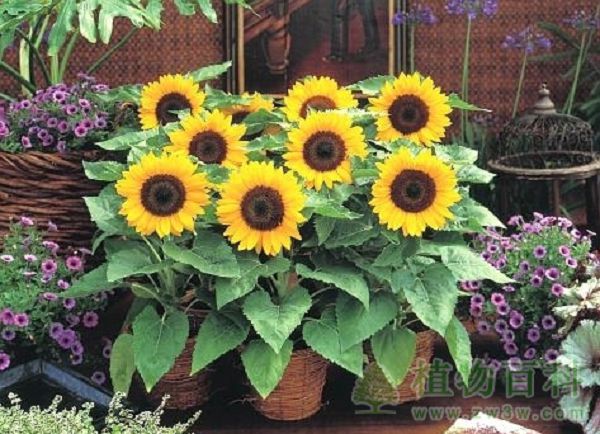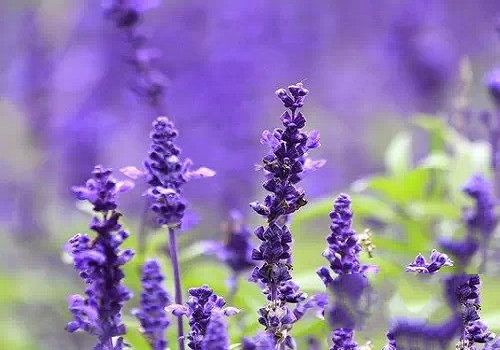Dwarf Sunflower planting method √ Flower planting √ Plant Encyclopedia

Dwarf sunflower is introduced from abroad sunflower, suitable for flower bed planting, generally plant height 40 cm, disk diameter 30 cm, main stem flowering, strong adaptability, generally adopted seedling transplanting, seedling age 25-30 days, plant row spacing 40 × 60 cm, can also be potted ornamental, family indoor four seasons, can be planted everywhere.
1. Variety selection
It is recommended to choose the big smile variety of dwarf sunflower, which has a plant height of 30 to 40 cm, a flower diameter of 10 to 17 cm, a bright golden single petal and a black flower heart. It can blossom 50 to 55 days after planting, which is suitable for potted plants and flower beds.
2. Sowing seeds
The seedlings are sowed and propagated, which are generally sown in April. The optimum temperature for germination is 15 to 18 ℃. The seedlings can be sowed in shallow pots or shallow boxes, with loose media, good water retention, asepsis and so on. Sowing on demand is appropriate, sowing 2 grains per hole, covering 1 to 2 cm thick medium after sowing, in order to maintain the humidity needed for germination, increase the stability of seedling stage and reduce the occurrence of shelled seedlings. Generally germinate 7 to 14 days after sowing, pay attention to ventilation and cooling after emergence, control humidity, and gradually see the light. The seeds do not need to be soaked. Just put two seeds in a small flowerpot with a diameter of about 20cm. If you are afraid of the low germination rate of seeds, you can put a few more seeds in the first place. )
3. Cultivation
Keep the soil moist when you first plant it. After emergence, as long as the leaves are absent, they are not short of water! Don't pour too much water, or the roots will rot. Be careful when watering. When the weather is hot, water it earlier in the morning and later in the evening. After emergence, leave two or three seedlings, more is not conducive to growth. Dwarf sunflowers like the sun, remember to keep enough light, more than 8 hours a day is better! Attention should be paid to the application of sufficient base fertilizer, mainly phosphorus and potassium fertilizer, and light nitrogen fertilizer.
Planting and maintenance when the seedlings come out one after another, one plant is left in each hole, and the seedling height is 7 to 8 centimeters. The basin soil should be sandy soil which is rich in humus and well drained. When planting, apply sufficient basal fertilizer to the bottom of the basin, and dig up the seedlings with more soil and less root damage, so as to make the plant recover quickly.
Fertilization should be applied once every 20 days during the growing period, but thin phosphorus and potassium fertilizer should be applied 2 or 3 times before flowering. Always keep the soil moist, especially when it is hot and dry in summer. In order to make the terminal bud of the main branch grow and develop healthily, the lateral (axillary) bud can be removed. A pillar should be set up for those with a slightly higher stem to prevent the wind from falling down. Artificial pollination during flowering can improve the seed setting rate.
4. Pest control
Common diseases and insect pests are powdery mildew and black spot. During the onset of powdery mildew, the leaves began to produce white round powdery spots, which were enlarged and connected into one piece, and then there were brown spots on the powdery mildew layer, and the plant growth stopped. When black spot disease occurs, the leaves give birth to dark brown or light yellow disease spots of different sizes, and then develop into brown spots, which are connected into large patches, making the leaves black and withered. When the disease occurs, the residual plants can be removed and sprayed with 75 {bf} chlorothalonil wettable powder or 70 {bf} methyl topiramate wettable powder for prevention and treatment. Insect pests are mainly caused by blind bugs and red spiders, which can be controlled by spraying 40 {bf} omethoate EC or 73 {bf} propargite EC 1500 times.
Related
- What if the leaves of potted flowers turn yellow?
- Florescence Control of several Flowers
- Anti-freezing technology and post-freezing nursing technology of flowers
- What is the classification of flowers? What are the common methods of flower classification?
- Prevention and control of alkali and acid damage of flowers in courtyard
- Technology of Anti-freezing and restoring growth of Flower seedlings in greenhouse and greenhouse
- How does flower fertilization not hurt the root? Fertilization technology of flowers
- Key points of disinfection in flower greenhouse
- Several pesticides that are banned or used cautiously in flowers
- How to fertilize the flowers that watch the leaves?



